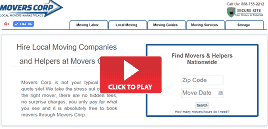Lifting and Carrying Techniques for Moving
How to Book a Mover

When you are hiring a moving company, make sure to check what their policy is on non-transportable items. This guide lists examples of items that movers cannot transport.
What Movers Will Not Move
Have you ever wondered what are the responsibilities and duties of the company who want to hire? Here is something about how movers work.
What Movers Do
Long distance move is not only time-consuming, but it is also an extra cost that you probably don't want to spend. There are many options to save money and one of them is to get a moving container.
Portable Storage Containers
The main task when relocating is to have an affordable, smooth, and efficient experience. In order to achieve such a plan, you need to have a planning checklist.
Four Weeks Moving Plan
How to protect the environment when moving? Having a green move is easier than you think, use the following tips when relocating into a new home.
Green Moving Tips
Furniture Lifting and Carrying Techniques
If you decide to move homes, whether down the street or across the country, there will likely be a lot of heavy lifting involved for extended periods of time. Lifting boxes, crates, furniture, and other household goods often exceeding 20, 30, 40, or 100+ pounds can harm your back and legs if not moved correctly.
Even long before you move, getting into the habit of learning how to lift, carry, push, and pull heavy objects will help you down the line where you may be spending weeks of time preparing for a move. The process as a whole involves quite a lot - packing up your property, dismantling larger objects, getting the items into the truck, taking the boxes and furniture off of the truck, then bringing it all inside and setting up your new home.Before understanding how to lift and carry heavy objects, it's important to know why there is such a heavy emphasis on learning these techniques in the first place. Many unnecessary injuries occur because of lifting objects that are too heavy, putting a strain on your spine, not lifting with your legs when you should, and carrying too much.
The damage that your body can sustain because of lifting may vary by many different types of pain, or in different locations - sometimes all at once or randomly changing throughout the day. Some back and leg pains may be acute and only last for a short while following a period of heavy lifting, like a move, where other times they are chronic and can interfere with your life for years to come. Short-term back problems may resolve themselves naturally through rest and patience; long-term pain will need medicine, physical therapy, and lifestyle changes to accommodate the damage done. Although there are many causes for back pain such as accidents, sports injuries, and some naturally occurring causes, preventing back pain because of improper lifting techniques is easy.Depending on the size and weight of an object, how far it has to be moved, and any potential obstacles in the way, the method used to lift and carry objects will differ greatly. However, there are still a few simple tips and techniques that can be used universally with most moving requirements. Before actually lifting up a heavy object, examine it carefully to assess its' weight and size, and plan out the path ahead to move it. It's best to plan out a clear path with little-to-no obstacles in your way.
If you know an object will be too heavy or awkwardly shaped to lift then ask for assistance in carrying it. When actually transporting the object, hold it close to your body towards your waist or upper legs - holding it out far away from you just puts more strain on your spine and will require more strength to hold it. Having a good grip is important to keep it at the best position, as in not too far away, so using gloves or keeping your hands on the edges can help maintain balance when lifting. If you do lift something heavy directly off of the ground, bend down and lift up using your legs and hips while keeping your back straight since this is where most back injuries occur. When moving and placing the object, don't twist your back and spine; instead, pivot with your feet and move your entire body, rather than just twisting. If there is a chance for you to use mechanical help such as push carts, trolleys, and so on, then definitely use them to not only make the process easier, but faster as well.Below is a list of resources that will explain how to lift and carry objects, the best ways to prepare for moving, and ways to get your body ready for a period of heavy lifting prior to starting through exercise.
| Resources For Moving | Moving Companies Near You | Find Local Movers In Your State |
|---|---|---|

About the Author:
Margarita Hakobyan is the founder and CEO of MoversCorp.com. She has published more than 300 articles about moving, storage, and home organizing, making her a moving specialist since she began writing about the moving industry in 2005.Copyright © 2024 Local Movers Corp All rights reserved 1-888-755-2212
